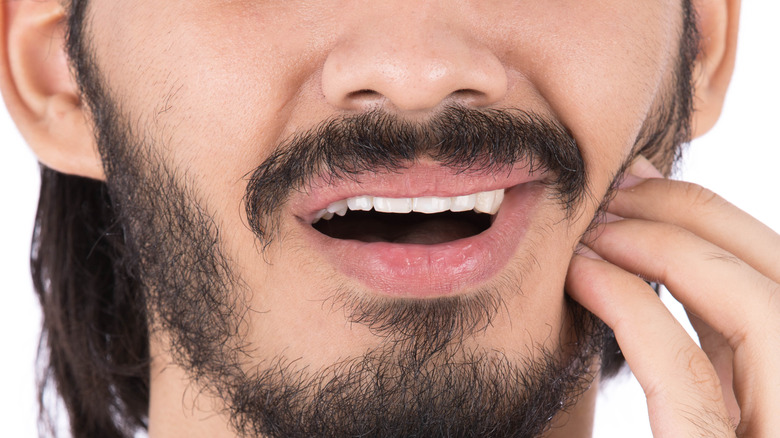How To Ease Annoying Lockjaw Symptoms At Home
While a little jaw tightness might not sound too serious in the short term, if left untreated, lockjaw can wreak havoc on our oral health. It can lead to ulcers, tooth decay, and in severe cases, malnutrition if the condition interferes with one's ability to eat (via Verywell Health). Characterized by muscle spasms in the jaw, lockjaw can affect the ears, neck, teeth, nose, as well as one or both sides of the face (via Healthline). In addition to pain and clicking noises, those with lockjaw may find that the joint becomes stuck and hinders their ability to move and fully open their mouth.
It doesn't take long before the pain of lockjaw can spread, prompting earaches or headaches, reports Verywell Health. The source of lockjaw can be traced to the use of certain medications, infection, facial trauma, as well as various health conditions (via Healthline). However, lockjaw can also develop out of everyday habits, such as excessive chewing or clenching or grinding your teeth. At the onset of symptoms, be sure to consult with your doctor. Otherwise, here are some at-home tips you can use to ease the tightness and discomfort of lockjaw.
Try these jaw exercises
Like any other muscle in the body, our jaw muscles can benefit from a little stretching. Healthline suggests beginning with some simple opening-and-closing motions of the mouth to help loosen the area. Next, you'll want to move into repetitions. Touch the tops of your bottom front teeth with your fingertips and slowly push your jaw downwards until you begin to feel mild discomfort in the affected area. Hold this position for 30 seconds and then release. Resume the starting position and repeat 3 times, progressively making your way up to 12 repetitions over time.
Another stretch to try is called the smile stretch. Healthline instructs you to smile as widely as you comfortably can. While doing so, open your mouth to drop your jaw about 2 inches. Take a deep breath in through the mouth and exhale as you release the smile. This exercise can be repeated as many as 10 times and you should feel the stretch in your face and neck muscles.
In addition, a little massaging may do the trick by boosting blood flow and easing muscle tension in the jaw (per Healthline). Throughout your day, use your fingertips to rub small circles into the muscles surrounding your ears. Some other quick tips: try alternating between a cold and hot compress placed on the affected area, recommends MedicineNet. To allow your jaw some rest, try sticking to softer foods on days when symptoms are aggravated, such as rice, fish, and yogurt.


